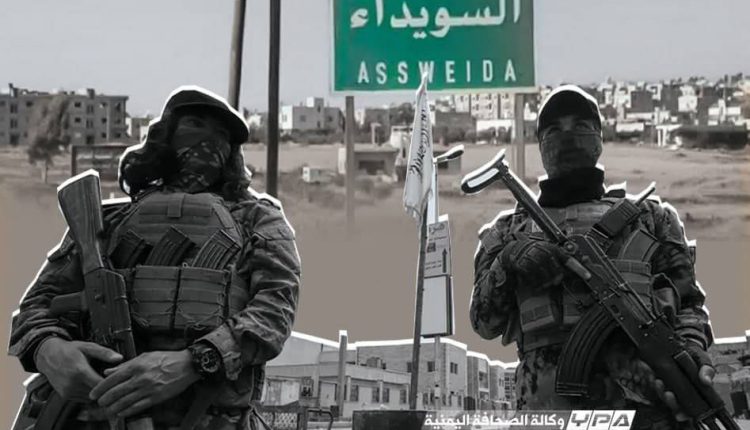SANAA, July 19 (YPA) – The southern Syrian province of Sweida has witnessed an unprecedented escalation following a renewed security eruption in the western part of the province between armed Bedouin tribesmen on the one hand and local Druze militants on the other.
This bloody scene recalls scenarios of sectarian violence and a series of previous unresolved clashes.
But behind the rising smoke and sectarian clashes, serious questions emerge: Who is igniting the fronts? And who benefits from reigniting the situation in a region that has been trying to distance itself from power struggles?
Villages on Fire: Tribal Revenge or Managed Tensions?
While the villages of the Syrian province of Sweida were enjoying a cautious calm, Bedouin tribes supported by the Syrian Interim Government attacked Druze areas in the Sweida countryside, burning down civilians’ homes in what became known as revenge attacks.
According to Syrian media outlets and human rights organizations, the spark began in the villages of Walgha and al-Mazra’a after gunmen believed to belong to Bedouin tribes burned property belonging to Druze residents. This prompted a large-scale armed response from local Druze factions, with fighters deployed at the village entrances.
Clashes have been concentrated in the villages of Walgha and al-Mazra’a, west of the city of Sweida, over the past few hours. This occurred after Bedouin gunmen burned property and homes belonging to members of the Druze community, according to local sources.
The clashes extended to the village of al-Surah al-Kabira, leading to a mass exodus of civilians from the contact zones amidst a state of popular panic.
Although the appearance suggests the outbreak of sectarian fighting, field testimonies from residents confirm that some Bedouin fighters came from outside the province, raising the possibility that the conflict is being transferred to Syria by parties seeking to confuse the situation.
A resident of the village of al-Surah al-Kabira, to which the conflict has spread, says that “unidentified vehicles were entering the area at night, transporting armed men to the vicinity of contact points, before departing toward the desert.”
Drone Intervention: Who’s Bombing Whom?
At the height of the clashes, a shocking surprise emerged: an unidentified drone targeted a gathering of armed Bedouin tribesmen near the village of Walgha.
Although no group claimed responsibility, field sources indicated that the drone “bore Israeli fingerprints.” This coincided with SANA’s announcement of an airstrike in the vicinity of Sweida, without providing further details.
Earlier, an Israeli drone had bombed a military vehicle belonging to the Syrian Transitional Government forces on the Dahr al-Jabal road, resulting in casualties among those forces.
Israeli aircraft had previously carried out an airstrike on a military vehicle belonging to the Syrian transitional government on the Dahr al-Jabal road, resulting in deaths and injuries. However, what is strange is that this attack coincided with a sudden withdrawal of government forces from Sweida, a move that has yet to be explained.
Activists on social media platforms wondered, are we witnessing coordination between the new Damascus authorities and the occupation government? And were Israeli aircraft permitted to carry out precise operations in parallel with the withdrawal of Syrian forces? This question confuses all attempts to interpret the situation.
Dangerous Leaks: “Israel” is Coordinating?
In a highly sensitive context, another surprise emerged from an official in the Israeli occupation government. He revealed—in an interview with the Hebrew media—that the occupation government had approved a limited entry of Syrian internal security forces into Sweida for 48 hours, referring to the coordination in light of what he described as “the fragile situation in the region.”
This statement sparked widespread controversy, revealing the existence of actual coordination channels between the Syrian transitional government in Damascus and the Israeli occupation.
This came amid a suspicious security withdrawal from Sweida and the deteriorating security situation the following day, following a bloody four-day round of clashes and accusations of tacit complicity in fueling sectarian tensions.
Syrian human rights organizations considered this statement “catastrophic,” as it indirectly implies that security decisions in southern Syria are now in the hands of the Israeli occupation, or at least under its cover. One activist described this as “a national disgrace and a sovereign scandal.”
Government Denial… But the Facts Speak
Despite the denial issued by the spokesman for the Ministry of Interior in the Syrian transitional government, Nour al-Din al-Baba, regarding the redeployment of forces in Sweida, satellite images and local reports confirm that the withdrawal was fully completed last Thursday, after four days of bloody clashes.
Was the withdrawal an escape under pressure? Or was it a planned tactical withdrawal within understandings with a third party?
The Scenario Is Repeated
The director of the Syrian Observatory for Human Rights told the BBC that what is happening in Sweida is “a rerun of the same old scenario, where clashes begin between the Druze and some Bedouins, and then security forces intervene under the pretext of imposing security.”
He confirmed that members of the security forces appeared in civilian clothes during the clashes, pointing to the burning of Druze homes and cars.
He added that the Ministry of Interior announced the dispatch of security reinforcements to the area, a move some see as a prelude to re-imposing the government’s grip on the province.
The director of the Syrian Observatory called for an immediate ceasefire and the start of a genuine dialogue between local communities, free from foreign interference. He warned that the continuation of the clashes could lead to the disintegration of the social fabric and open the door to further foreign intervention, most notably the Israeli occupation.
Absent Humanitarian Dimension
Civilians were, as usual, the most prominent victims, with local organizations recording the displacement of dozens of burning villages amid warnings of a humanitarian crisis due to food and medicine shortages, especially in the western regions of Sweida.
In contrast, videos circulating on social media show displaced Bedouins being welcomed into Druze homes, demonstrating the residents’ adherence to the principle of coexistence that has historically characterized Sweida.
But this coexistence appears threatened today more than ever, with calls from some tribes for a “general mobilization toward Sweida” and warnings of the outbreak of a civil war orchestrated from across the border.
Who benefits?
Observers believe that what is happening in Sweida is not merely a local clash but rather part of a larger plan to reshape southern Syria by inciting sectarian chaos and pushing local forces into conflict, thus weakening any attempt to establish self-rule or a national project independent of foreign influence.
The Israeli occupation forces, which have made no secret of their support for the idea of “dividing Syria into spheres of influence,” may see these events as an opportunity to consolidate their security control over the border and prevent the emergence of any unified force in the south.
The Syrian transitional government, meanwhile, faces accusations of “managing the crisis from behind” and abandoning its sovereign responsibilities in favor of undisclosed agreements.
What is happening in Sweida cannot be reduced to a fleeting tribal conflict. All evidence suggests that the situation goes beyond a local conflict toward a dirty international game being waged on a land burdened with blood and division.
Given the complete absence of national dialogue and the complicity of some parties, Sweida could be the prelude to a larger explosion that could engulf all of southern Syria unless this trend is quickly curbed.
YPA


